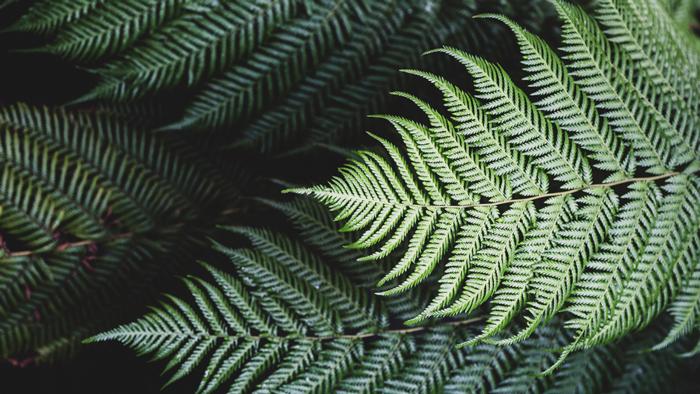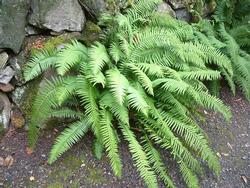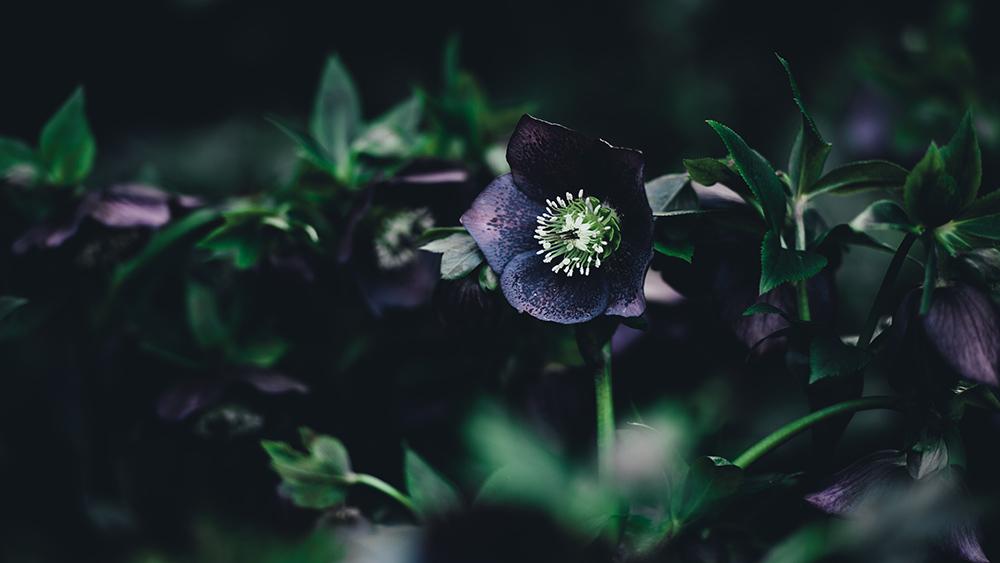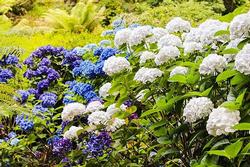Ferns & Shade-loving Plants
Have a shady nook that needs attention? There is a world of gorgeous plants up for the job. They come in every imaginable shade of green – from pastel to chartreuse, emerald, and deep forest green. Shade plants are often slower growing than sun-loving species. Many bear striking flowers that light up shady spots. If your garden gets 3 to 4 hours or less of sun per day, there are numerous ferns and shade-loving plants awaiting you.
Use our list of > FERNS
Use our list of > PLANTS FOR SHADE
Ferns lend lush, tropical feel to shady nooks

Ferns are among the oldest plants on earth, with fossil records dating back hundreds of millions of years. These plants dominated the earth, some growing hundreds of feet tall. Most went extinct, leaving behind the fossilized form in immense beds of coal that we continue to tap today. We also tap the plants themselves, thanks to their versatility, attractive foliage, and ease of growing. Ferns provide a lush, tropical feel to shady garden nooks, make nice houseplants, and are useful in floral arrangements.
Use our list of > FERNS
Fern facts

Where: Found in all parts of the world. The four habitats that ferns call home include moist, shady forests, sheltered crevices in rocky cliffs, acidic wetlands such as bogs and swamps, and tropical regions. They have adapted to a wide variety of climates, surviving hot to freezing temperatures, low and high elevations, and vastly different terrains from deserts to snow-covered mountains.
Size: Range from tiny plants growing in rock crevices to more than 50-foot-tall tree ferns.
Water: Many ferns appreciate regular moisture, but some, such as California’s giant chain fern (Woodwardia fimbriata) and western sword fern (Polystichum munitum) can survive drought.
Soil: Some ferns don’t even need soil, growing as epiphytes out of large tree branches instead.
Propagation: Fern spores are produced in specialized organs called sporangia. Spores look like dots on the undersides of the fronds. Ferns drop millions of spores onto the ground. When a spore finds the perfect environment, it grows into a fern.
Deer: Ferns are often ignored by deer.
Shade-loving plants wake up the garden

For many, the perfect garden conjures images of a dappled woodland filled with tree-shaded ferns, shy buds appearing from the deep green shade, and perhaps the sound of running water. Romantic as this vision may be, gardening in the shade can be challenging. If you are planning a shade garden -- either because you live on a northern slope or have a patch of ground in the shadow of a tree or building -- there are many beautiful plants that you can grow.
Use our list of > PLANTS FOR SHADE
Learn about plants that brighten shady nooks or that create a restful, serene environment. Many shade-loving plants have thin leaves with large surface areas, an adaptation that allows them to be efficient at photosynthesis in low light conditions.
Tips for gardening in the shade
Rely on shade-loving plants
Plants grown in too much or too little sun are at risk for problems.
Watch sun tolerance
Shade plants are most likely to tolerate some sun in the early morning.
Plant under trees with care
• Tree roots can take water and nutrients from the understory plants.
• It's possible, but difficult, to add shrubs, bulbs or grasses where tree roots have expanded.
• Tree canopies can prevent rain from reaching plants underneath. Consider watering more frequently or chose plants that don't require much water.
• Add compost to help provide the extra nutrients tree roots may otherwise steal.
• If surface roots aren't too thickly established, try small annuals or a few seeds covered with a thin layer of mulch (keep it 2 inches away from the tree trunk).
• Another way to deal with a root problem is to build raised beds.
Avoid lawn: Conventional lawn grasses do not perform well in shade.
Tried and true: plants that light up the shade

• Azalea and rhododendron (Rhododendron)
• Camellia
• Hydrangea
• Cyclamen
• Fuchsia
• Impatiens
• Viola
• Foxglove (Digitalis)
• Hellebore (Helleborus)
• Hosta
• Clivia
• Japanese anemone (Anemone)
Check the shade section of your local nursery for new cultivars.
Shade-loving natives: all the benefits, less sun required
California native plants offer a treasure chest of dry-shade choices. These plants generally prefer little to no summer water and work especially well on shady hillsides. A few to consider:
• Pink flowering currant (Ribes sanguineum glutinosum) offers dramatic clusters of pendulous flowers and is very drought tolerant in coastal gardens.
• California buttercup (Ranunculus californicus) is drought tolerant.
• Sticky monkey flower (Mimulus) grows in partial shade and is drought-tolerant.
• Native strawberry (Fragaria vesca) is a low, spreading groundcover that produces small but sweet fruit.
